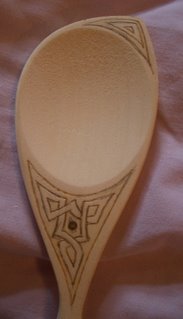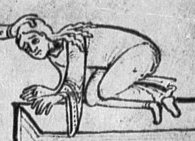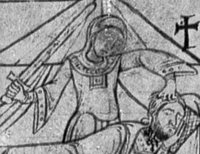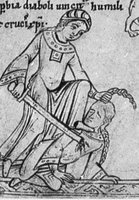Austrian lamps Several sets of lamps in this manuscript have an unusual shape - baggy rather than tapered at the bottom like this. I guess this shape would work well enough, but the tapered shape works superbly as a hanging lamp (it sort of self balances). The chains the lamps hang from seem to attach near the bottom of the lamp, so I assume they pass under the baggy bits (presumably there are 3 of them) or there is a fastening at the side that we can't see.









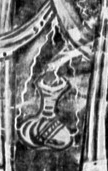

(in order)
Fol. 13 (2 lamps),
Fol. 27,
Fol. 37v (3 lamps)
Fol. 39,
Fol. 56 (2 lamps),
Fol.68,
Fol.102v.
Periscope book, Saint Erentrud Abbey, Salzburg around 1140 (München, Bayerische Staatsbibliothek, Cod. lat. 15903)
And from annother Austrian manuscript:
 De Laudibus sanctae Crucis, Regensburg c1170/75 (Bayerische Staatsbibliothek, ms. lat. 14159) fol 4v
De Laudibus sanctae Crucis, Regensburg c1170/75 (Bayerische Staatsbibliothek, ms. lat. 14159) fol 4v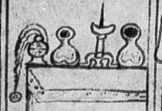
From the same page, left to right: censer, lamp, candlestick, lamp sitting on an altar in a church.
Now that my preconception about lamps being just one shape is broken, I'm going to do a survey of lamps by geographical location.
Lamps from other places
France Stained Glass window
Stained Glass window, Chartres Cathedral, 12th C?
We can see the chains on the lamp, I'm not sure why there is a bowl below the lamp. (there shouldn't be drips to catch).
Complete picture
somewhere on this section of artserv.
England copenhagen psalter
copenhagen psalter England, 1175-1200 (
Kongelige Bibliotek, MS Thott 143 2º) .
f9vYes, the lamp is hovering in mid air, I assume the artist never got back to draw in the strings.
 winchester psalter
winchester psalter Winchester (Priory of St Swithun or Hyde Abbey); between 1121 and 1161(British Library MS Cotton Nero C IV)
f10 Nativity.
St Albans Psalter, St Albans c.1131


 p50
p50.
The Three Women at the Sepulchre, p48.
The Entombment, p28.
The Presentation at the TempleThe chains on these lamps are drawn as attached to the middle of the body of the lamp, not the top as in the other english examples.


1160-70 Winchester Morgan Library 619
Scenes from the life of David and SamuelThere appears to be a single chain with a blob on the end hanging down below the lamp. This might be some device to allow lowering of the lamp maybe?
Italy

Rome, San Clemente, narthex of the lower church,
Miracle at the tomb of St Clement. Wall painting. 1084/1115
What a lovely shape of lamp. Or it could be some kind of censer I suppose, but why would you have 3 of them? You can also just make out some kind of bar or disc where the chains meet and then attaches to the ceiling with one chain.
Spain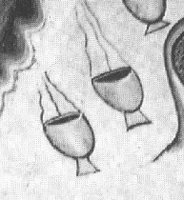


Santa Maria de Mur, apse,
Christ in Majesty. Wall painting. Mid twelfth century(?). Boston, Museum of Fine Arts
Spain (Catalonia)
These ones contrast with the lamps from the st Albans psalter by having their chains attached at the top rim of the lamp.
Conclusion
Send me more examples of 12th C lamps so I can make a better survey. But I can say for now that there are a lot more shapes of lamp above than I expected, even in English examples.
And while we are on the topic of lighting.....
candlesticks
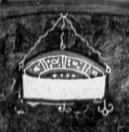 Periscope book
Periscope book, Saint Erentrud Abbey, Salzburg around 1140 (München, Bayerische Staatsbibliothek, Cod. lat. 15903),
fol 49v Doubting Thomas.
Also from the first manuscript, what I think is a candelabra. There is a magnificent
11th C one at
St Mary's Cathedral, Hildesheim, Germany. I've seen other Romanseque ones, both islamic and christian, in museum catalogues, and the general design differs little. One interesting thing to note is that the wheel shape was used as frequently for oil lamps as for candles. In fact I find the candles on the hildesheim one suspicious - most 12th C candle holders were of the dish and prong type, not the socket type which was useless without consistent width candles. Some socket shape candle holders developed from socket shaped oil lamp holders, although I'm not sure the hildesheim one is consistent with that either, so maybe it is just an early example of socketed candle holders.
An example candlestick (the prong type):
Samson on a lion, 1st half 13th C, Northern Germany


Bohemia (?):
the guards sleeping at the Sepulchre, from a Gospel Book, MS. Ia folio 49. Late eleventh century. Gniezno Cathedral Library

[right]Rome, San Clemente, narthex of the lower church,
Miracle at the tomb of St Clement. Wall painting. 1084/1115
The lamps and whole picture (with more identical candlesticks) we have seen above.


Santa Maria de Tarrasa, apse of the south transept,
Martyrdom and Apotheosis of St Thomas Becket. Wall painting. c. 1185-1200
Conclusions:I need more examples of candlesticks too, but this tallys with what I've seen in extant examples (I'll dig out links and post them someday if I find time) - these are all of the prong and dish type, no socket shaped holders here. Note that all the candles are in churches (but only a number of the lamps), which backs up what I've been told about other sources of lighting being more common outside the church. Candles were expensive (especially nice smelling beeswax ones), but important in devotional services (i think that Catholic tradition of lighting a candle is a very old one). In a domestic setting, given the choice of a smelly tallow candle or an olive oil lamp, I know which I'd generally choose.
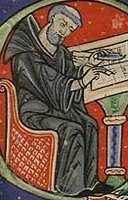 GKS 182 2°: Vita Anselmi. Vita Malachiae. Sermo
GKS 182 2°: Vita Anselmi. Vita Malachiae. Sermo Vatican Bibl. Apost Vat, Ms Lat 4922, Vita Mathildis
Vatican Bibl. Apost Vat, Ms Lat 4922, Vita Mathildis Bibliothèque Nationale de France, Paris MS lat1 (Vivian Bible) Tours 845/6
Bibliothèque Nationale de France, Paris MS lat1 (Vivian Bible) Tours 845/6 Valenciennes Library
Valenciennes Library St Angelo in Formis, miniatures from the Register
St Angelo in Formis, miniatures from the Register Bibliothèque nationale de France, Département des Manuscripts, Division occidentale Latin 16745 (bible des capucins )
Bibliothèque nationale de France, Département des Manuscripts, Division occidentale Latin 16745 (bible des capucins ) British Library MS Cotton Nero C. IV (Winchester Psalter)
British Library MS Cotton Nero C. IV (Winchester Psalter) GKS 181 2°: Vita Bernhardi. Miracula. Radbertus
GKS 181 2°: Vita Bernhardi. Miracula. Radbertus Wall Painting, Anagni, Cathedral Crypt c1255
Wall Painting, Anagni, Cathedral Crypt c1255 Berlin Print Room, MS 16
Berlin Print Room, MS 16
